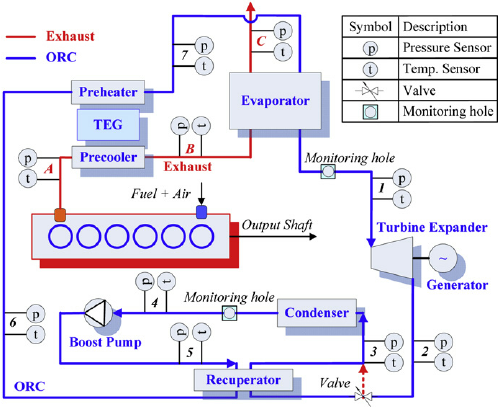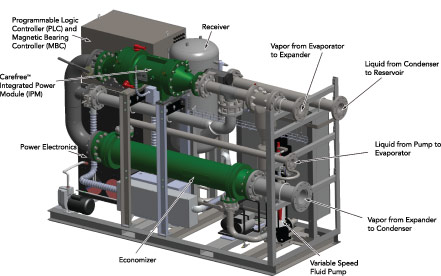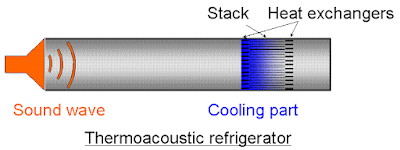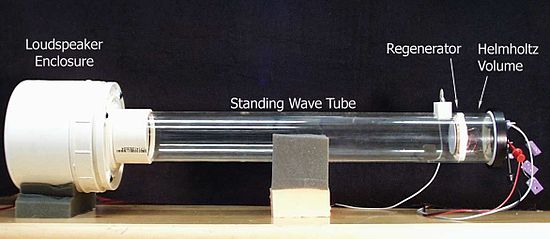The internal combustion engine used in majority of cars at the present time do not use their fuel input
very efficiently. A majority of this energy is dissipated as heat in the exhaust. The related problems of
global warming and dwindling fossil fuel supplies has led to improving the efficiency of the internal
combustion engine being a priority. One method to improve the efficiency is to develop methods to
utilise heat in car exhausts that is usually wasted. Two promising technologies that were found to be
useful for this purpose were thermoelectric cells (TECs) and heat pipes. Therefore this project involved
making a bench type, proof of concept model of power production by thermoelectric cells using heat
pipes and hot engine exhaust gases. 8 cells were used and managed to produce 6.03 W when charging
the battery. The system operated with a heat to electricity conversion efficiency of 1.43%. The discrepancy
between the actual efficiency and the predicted efficiency of 2.31% is most likely due to the cells not
operating at their optimum voltage. The predicted efficiency is approximately 1/9 of the Carnot efficiency
and the actual efficiency is approximately 1/15 of the Carnot efficiency.
We all know that Engineering is an important and learned profession, The Mechanical engineering finds its application in the archives of various ancient and medieval societies throughout mankind. In ancient Greece, the works of Archimedes (287–212 BC) deeply influenced mechanics in the Western tradition, Here we have a blog "Talk4technology", Primarily for sharing the diversifying ideas & aspects in the mechanical engineering field....
Sunday, 17 July 2016
Saturday, 9 July 2016
THERMO ACOUSTIC REFRIGERATION
Thermo
acoustic have been known for over years but the use of this phenomenon to
develop engines and pumps is fairly recent. Thermo acoustic refrigeration is
one such phenomenon that uses high intensity sound waves in a pressurized gas
tube to pump heat from one place to other to produce refrigeration effect. In
this type of refrigeration all sorts of conventional refrigerants are
eliminated and sound waves take their place. All we need is a loud speaker and
an acoustically insulated tube. Also this system completely eliminates the need
for lubricants and results in 40% less energy consumption. Thermo acoustic heat
engines have the advantage of operating with inert gases and with little or no
moving parts, making them highly efficient ideal candidate for environmentally
safe refrigeration with almost zero maintenance cost.
A thermo acoustic device basically consists of heat exchangers, a resonator, and a stack (on
standing wave devices) or regenerator (on
travelling wave devices). Depending on the type of engine a driver or loudspeaker might be used
as well to generate sound waves. Compared to vapor
refrigerators, thermo acoustic refrigerators have no ozone-depleting or toxic coolant.
Modern research and development of thermo acoustic systems is largely based
upon the work of Rottand later Steven Garrett, and Greg Swift, in which linear
thermo acoustic models were developed to form a basic quantitative
understanding, and numeric models for computation. Commercial interest has
resulted in niche applications such as small to medium scale cryogenic applications.The
aim of this report to study the basics a thermoacoustic refrigerator, its
components and design.
From
creating comfortable home environments to manufacturing fast and efficient
electronic devices, air conditioning and refrigeration remain expensive, yet
essential, services for both homes and industries. However, in an age of
impending energy and environmental crises, current cooling technologies
continue to generate greenhouse gases with high- energy costs.
Thermoacoustic refrigeration is an innovative alternative
for cooling that is both clean and inexpensive. Thermo acoustic devices take
advantage of sound waves reverberating within them to convert a temperature
differential into mechanical energy or mechanical energy into a temperature
differential.Refrigeration relies on two
major thermodynamic principles. First, a fluid’s temperature rises when
compressed and falls when expanded. Second, when two substances are placed in
direct contact, heat will flow from the hotter substance to the cooler one.
While conventional refrigerators use pumps to transfer heat on a macroscopic
scale, thermoacoustic refrigerators rely on sound to generate waves of pressure
that alternately compress and relax the gas particles within the tube.
Friday, 8 July 2016
SOLAR SAIL
Solar sails are a form of spacecraft propulsion using the radiation pressure from stars to push large ultra-thin mirrors to high speeds. Light sails could also be driven by energy beams to extend their range of operations, which is strictly beam sailing rather than solar sailing. Solar sail craft offer the possibility of low-cost operations combined with long operating lifetimes. Since they have few moving parts and use no propellant, they can potentially be used numerous times for delivery of payloads. Solar sails use a phenomenon that has a proven, measured effect on spacecraft. Solar pressure affects all spacecraft, whether in interplanetary space or in orbit around a planet or small body. A typical spacecraft going to Mars, for example, will be displaced by thousands of kilometres by solar pressure, so the effects must be accounted for in trajectory planning, which has been done since the time of the earliest interplanetary spacecraft of the 1960s. Solar pressure also affects the attitude of a craft, a factor that must be included in spacecraft design. The total force exerted on an 800 by 800 meter solar sail, for example, is about 5 newtons at Earth's distance from Sol, making it a low-thrust propulsion system, similar to spacecraft propelled by electric engines. The concept of a huge, ultra-thin sail unfurling in space, using the pressure of sunlight to provide propellant-free transport, hovering and exploration capabilities, may seem like the stuff of science fiction. Now, a NASA team developing the "In-Space Demonstration of a Mission-Capable Solar Sail" or Solar Sail Demonstrator for short intend to prove the viability and value of the technology in the years to come.
Several upcoming missions aim to harness the subtle push of sunlight, using gossamer "solar sails" to cruise through the heavens like boats through the sea. Such propellant-free propulsion could take craft cheaply and efficiently to a variety of destinations, from locations in near-Earth space to the edge of the solar system and beyond, advocates say.
A spacecraft equipped with a sail 1,300 feet (400 meters) wide, for example, could travel 1.3 billion miles (2.1 billion kilometers) per year, allowing it to escape the sun's sphere of influence in just a decade or so, according to researchers behind the Interstellar Probe, a NASA concept mission proposed about 15 years ago.
As the photons of sunlight strike the sail and bounce off, they gently push the sail along by transferring momentum to the sail. Because there are so many photons from sunlight, and because they are constantly hitting the sail, there is a constant pressure (force per unit area) exerted on the sail that produces a constant acceleration of the spacecraft. Although the force on a solar-sail spacecraft is less than conventional chemical rockets, such as the space shuttle, the solar-sail spacecraft constantly accelerates over time and achieves a greater velocity. It's like comparing the effects of a gust of wind versus a steady, gentle breeze on a dandelion seed floating in the air. Although the gust of wind (rocket engine) initially pushes the seed with greater force, it dies quickly and the seed coasts only so far. In contrast, the breeze weakly pushes the seed during a longer period of time, and the seed travel farther. Solar sails enable spacecraft to move within the solar system and between stars without bulky rocket engines and enormous amounts of fuel.

In order for sunlight to provide sufficient pressure to propel a spacecraft forward, a solar sail must capture as much Sunlight as possible. This means that the surface of the sail must be big – very big. Cosmos 1 is a small solar sail intended only for a short mission. Nevertheless, once it spreads its sails even this small spacecraft will be 10 stories tall, as high as the rocket that will launch it. Its eight triangular blades are 15 meters (49 feet) in length, and have a total surface area of 600 square meters (6500 square feet). This is about one and a half times the size of a basketball court.
PRINCIPLE OF SOLAR SAIL
The fundamental principle of solar sailing is illustrated in Figure 2. If the solar sail is a perfect reflector, the combined impulse of the incident and reflected photons produce a resulting force on the solar sail that is nearly normal to the plane of the sail. By orienting the sail such that the resulting force opposes the motion of the spacecraft’s orbit, the sail causes the spacecraft to lose orbital angular momentum and spiral inwards towards the attracting body. On the other hand, if the resulting force vector is aligned such that the net force is increasing the orbital angular momentum, the orbit’s energy grows, and the spacecraft spirals out from the sun. Changing the angle of the sail’s surface normal relative to the sun can thus actuate the solar sail’s orbit in a desired manner

The Basic Principle behind Solar Sailing
The reflective nature of the sails is key. As photons (light particles) bounce off the reflective material, they gently push the sail along by transferring momentum to the sail. Because there are so many photons from sunlight, and because they are constantly hitting the sail, there is a constant pressure (force per unit area) exerted on the sail that produces a constant acceleration of the spacecraft. Although the force on a solar-sail spacecraft is less than a conventional chemical rocket, such as the space shuttle, the solar-sail spacecraft constantly accelerates over time and achieves a greater velocity.
Electromagnetism
Sunlight exerts a very gentle force. A square mirror 1 kilometer on a side would only feel about 9 Newton or 2 pounds of force. Fortunately, space is very empty and clean compared to Earth, so there is plenty of room for a 1 kilometer wide sails to maneuver, and there is no noticeable friction to interfere with your 9 Newton of thrust.
TACKING OF SOLAR SAILS
As every sailor knows, to tack or beat a sailboat is to sail the boat at an angle into the wind. Solar sails can do their own form of tacking by using the force of sunlight pushing out from the sun to actually move closer the sun.
Spacecraft, including solar sails, travel around the sun in orbits. A spacecraft that is propelled by a rocket can shrink its orbit, and thus move closer to the sun, by thrusting the rocket in the opposite direction as the spacecraft's motion. Similarly, if a solar sail can produce thrust in the opposite direction as the spacecraft's motion, its orbit will also shrink. By producing thrust in the same direction as the spacecraft's motion, the orbit will expand, and the spacecraft will move farther away from the sun.
Travelling towards the sun

Travelling away from the sun

Solar sails come in three major designs:
- Square sail
- Heliogyro sail
- Disc sail
SQUARE SAIL

Concept design of 3-axis stabilized square solar sail system.
HELIOGYRO SAIL

Concept design of heliogyro solar sail system.
SAIL DEPLOYMENT

Concept of solar sail deployment system
PROJECTS OPERATING OR COMPLETED
IKAROS 2010
On 21 May 2010, Japan Aerospace Exploration Agency (JAXA) launched the world's first interplanetary solar sail spacecraft "IKAROS" (Interplanetary Kitecraft Accelerated by Radiation of the Sun) to Venus.

NANO SAIL D 2010

Nano sail D 2010
PROJECTS IN DEVELOPMENT OR PROPOSED
SUN JAMMER
LIGHT SAIL
CONCLUSION
The major advantage of a solar-sail spacecraft is its ability to travel between the planets and to the stars without carrying fuel. Solar-sail spacecraft need only a conventional launch vehicle to get into Earth orbit, where the solar sails can be deployed and the spacecraft sent on its way. These spacecraft accelerate gradually, unlike conventional chemical rockets, which offer extremely quick acceleration. So for a fast trip to Mars, a solar-sail spacecraft offers no advantage over a conventional chemical rocket. However, if you need to carry a large payload to Mars and you're not in a hurry, a solar-sail spacecraft is ideal. As for traveling the greater distances necessary to reach the stars, solar-sail spacecraft, which have gradual but constant acceleration, can achieve greater velocities than conventional chemical rockets and so can span the distance in less time. Ultimately, solar-sail technology will make interstellar flights and shuttling between planets less expensive and therefore more practical than conventional chemical rockets.
International space agencies and some private corporations have proposed many methods of transportation that would allow us to go farther, but a manned space mission has yet to go beyond the moon. The most realistic of these space transportation options calls for the elimination of both rocket fuel and rocket engines replacing them with sails. Solar sail technology will eventually play a key role in long-distance NASA missions. But just how far will these solar sails be able to take us and how fast will they get us there is still unanswerable. As we found out in the last section, solar sails would not initially be driven by the amount of force that is used to launch the space shuttle.
NASA believes that the exploration of space is similar to the tale of the "Tortoise and the Hare," with rocket-propelled spacecraft being the hare. In this race, the rocket-propelled spacecraft will quickly jump out, moving quickly toward its destination. On the other hand, a rocket less spacecraft powered by a solar sail would begin its journey at a slow but steady pace, gradually picking up speed as the sun continues to exert force upon it. Sooner or later, no matter how fast it goes, the rocket ship will run out of power. In contrast, the solar sail craft has an endless supply of power from the sun.
Additionally, the solar sail could potentially return to Earth, whereas the rocket powered vehicle would not have any propellant to bring it back.
As it continues to be pushed by sunlight, the solar sail-propelled vehicle will build up speeds that rocket powered vehicles would never be able to achieve. Such a vehicle would eventually travel at about 56 miles/sec (90 km/sec), which would be more than 200,000 mph (324,000 kmph). That speed is about 10 times faster than the space shuttle's orbital speed of 5 miles/sec (8 km/sec). To give you an idea how fast that is, you could travel from New York to Los Angeles in less than a minute with a solar sail vehicle traveling at top speed.
If NASA were to launch an interstellar probe powered by solar sails, it would take only eight years for it to catch the Voyager 1 spacecraft (the most distant spacecraft from Earth), which has been traveling for more than 20 years. By adding a laser or magnetic beam transmitter, NASA said it could push speeds to 18,600 miles/sec (30,000 km/sec), which is one-tenth the speed of light. At those speeds, interstellar travel would be an almost certainty.
Subscribe to:
Comments (Atom)




